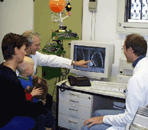How is childhood cancer treated?
Author: Gesche Tallen, MD, PhD, Editor: Maria Yiallouros, Reviewer: Prof. Dr. med. Dr. h. c. Günter Henze, English Translation: Hannah McRae, Last modification: 2015/01/13 https://kinderkrebsinfo.de/doi/e1830
Cancer cells can trick the immune system of the human body. As a consequence, a cancer patient is not able to fight this fatal disease and its resulting symptoms by him-/herself. Young cancer patients need special, age-adjusted treatment to have a chance of survival, while maintaining appropriate life-quality.
Each type of cancer that occurs in children or adolescents is different. Hence, each childhood cancer is treated differently. In general, current treatment concepts include chemotherapy with an effective combination of different agents (multiagent chemotherapy), so that the cancer cells are attacked in more than one way.
For a variety of cancers, multiagent chemotherapy is combined with surgery and sometimes radiation therapy (multimodal treatment). In specific circumstances, stem cell transplantation (SCT) provides a life-saving treatment option for patients with highly aggressive and/or recurrent cancers.
The key of success in paediatric oncology in Germany and numerous other countries during the last decades has been the conduct of clinical studies of the National Society of Paediatric Oncology/Haematology (GPOH), as well as the Children's Oncology Group (COG for North America) which were formerly defined as therapy optimising studies.
The concept of these clinical studies involves the comparative testing of the effectiveness of multimodal treatment concepts based on patients' individual risk-factors and standardised treatment protocols. It is not based on studying single drugs. These clinical studies are performed throughout numerous treatment centres (multicentred, international studies) and involve close collaboration between all stakeholders: Patients, families, paediatric oncologists, surgeons, radiologists, researchers, psychologists, social workers and many more.

